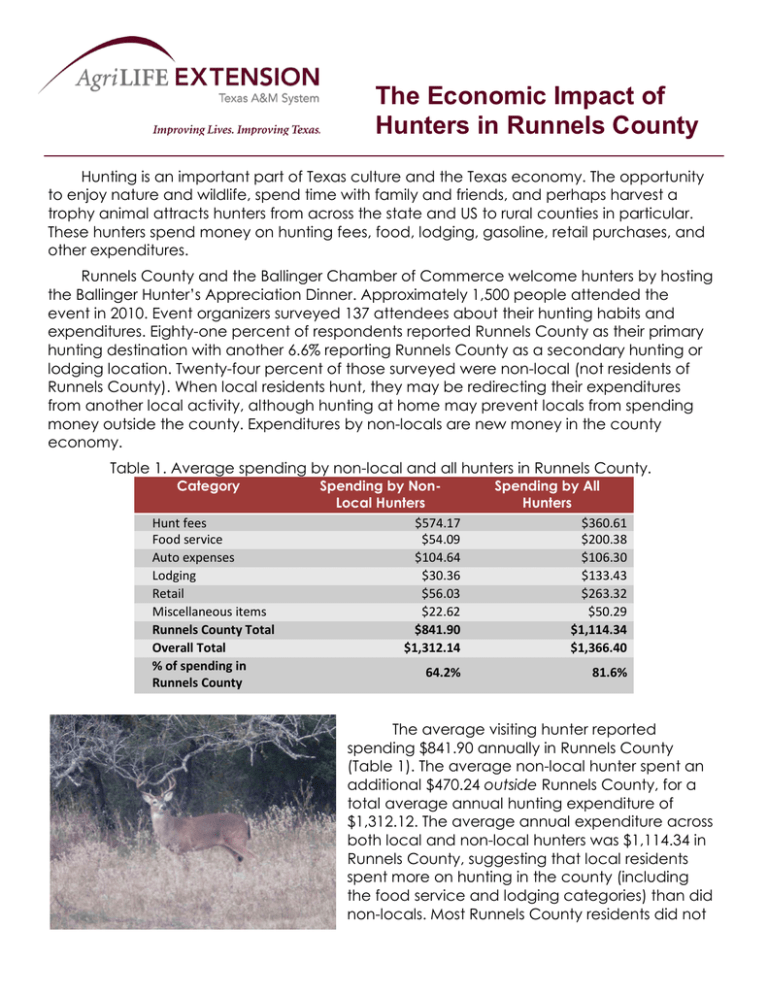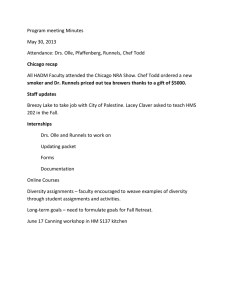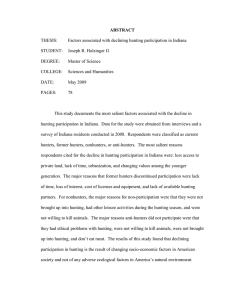The Economic Impact of Hunters in Runnels County
advertisement

The Economic Impact of Hunters in Runnels County Hunting is an important part of Texas culture and the Texas economy. The opportunity to enjoy nature and wildlife, spend time with family and friends, and perhaps harvest a trophy animal attracts hunters from across the state and US to rural counties in particular. These hunters spend money on hunting fees, food, lodging, gasoline, retail purchases, and other expenditures. Runnels County and the Ballinger Chamber of Commerce welcome hunters by hosting the Ballinger Hunter’s Appreciation Dinner. Approximately 1,500 people attended the event in 2010. Event organizers surveyed 137 attendees about their hunting habits and expenditures. Eighty-one percent of respondents reported Runnels County as their primary hunting destination with another 6.6% reporting Runnels County as a secondary hunting or lodging location. Twenty-four percent of those surveyed were non-local (not residents of Runnels County). When local residents hunt, they may be redirecting their expenditures from another local activity, although hunting at home may prevent locals from spending money outside the county. Expenditures by non-locals are new money in the county economy. Table 1. Average spending by non-local and all hunters in Runnels County. Category Hunt fees Food service Auto expenses Lodging Retail Miscellaneous items Runnels County Total Overall Total % of spending in Runnels County Spending by NonLocal Hunters $574.17 $54.09 $104.64 $30.36 $56.03 $22.62 $841.90 $1,312.14 Spending by All Hunters $360.61 $200.38 $106.30 $133.43 $263.32 $50.29 $1,114.34 $1,366.40 64.2% 81.6% The average visiting hunter reported spending $841.90 annually in Runnels County (Table 1). The average non-local hunter spent an additional $470.24 outside Runnels County, for a total average annual hunting expenditure of $1,312.12. The average annual expenditure across both local and non-local hunters was $1,114.34 in Runnels County, suggesting that local residents spent more on hunting in the county (including the food service and lodging categories) than did non-locals. Most Runnels County residents did not report their hunting expenditures and were therefore excluded from the average spending calculation. Thus the average local expenditure may have been influenced by outlier responses. Still, the spending levels were consistent with spending in surrounding counties. Direct spending by hunters is not the only benefit to the local economy. A hunter’s direct expenditure at a local store, café, or hotel is multiplied as firms purchase inputs (indirect effect) and pay employees who also make regional purchases (induced effect). The total effect on employment, labor income, value added (contribution to gross regional product), and output in the county is greater than the initial dollar spent. Of course, some of the original expenditure leaks out of the regional economy, for example as inventory is imported from other regions, employees commute from other regions, and businesses and households pay state and federal taxes. Table 2. Economic Impact of Non-Local Hunters to the Runnels County Economy. Direct Effect Total Effect Employment 2.4 3.3 Labor Income $42,800 $65,600 Value Added $68,600 $120,800 Output $304,200 $389,300 Hunting by non-local game dinner attendees alone contributed 2.4 direct full- and part-time jobs and $304,200 in gross sales (output) in Runnels County (Table 2). Using the IMPLAN modeling system (Minnesota IMPLAN Group, 2010, Hudson, WI), these visiting hunters expenditures resulted in 3.3 jobs across the entire economy. The $389,300 in gross sales generated across the economy included a $120,800 impact on gross regional product (value added) and $65,600 in labor income. Labor income is a subset of value added, which is part of output, so these figures cannot be summed. Table 3. Economic Contribution of All Hunters to the Runnels County Economy. Direct Effect Total Effect Employment 24.3 28.0 Labor Income $461,800 $565,700 Value Added $739,400 $960,300 Output $1,671,500 $2,040,800 Most survey respondents were Runnels County residents. Although residents’ hunting expenditures do not represent new economic activity, they do make a contribution to the local economy. When local and non-local game dinner attendees’ expenditures were combined, they supported 24.3 direct jobs and $1,671,500 in output in Runnels County (Table 3). These overall expenditures contributed 28.0 jobs, $565,700 in labor income, $960,300 in value added, and $2,040,800 in output across the entire economy annually. Of course, these figures represent only the economic contributions of hunters attending the game dinner. Hunting expenditures and economic contributions by all hunters over the year are likely larger. The average hunter reported hunting 22.1 days over the year. The average hunting party included 6.7 people. Most survey respondents (56.2%) visited hunting land as a guest or family member, 42.3% owned their hunting land, 32.8% leased hunting land, and 10.9% hunted public lands. The most popular reason for hunting in Runnels County was spending time with family and friends (58.4% of survey respondents). Rebekka Dudensing and Marty Gibbs CED11-10 June 2011



